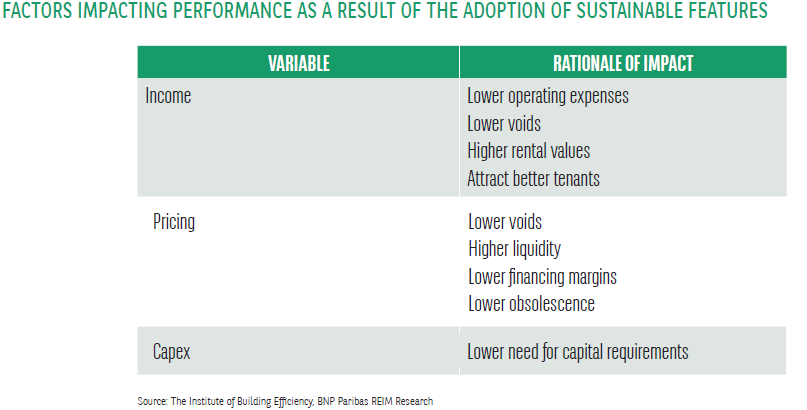The importance of taking sustainability into account in the real estate industry
As Barbara Knoflach, Deputy Chief Executive Officer of BNP Paribas Real Estate in charge of Investment Management points out, “research is showing that green properties improve returns and future-proof the value of real estate investments. These types of properties have lower operating expenses and voids, and can generate higher rents. Green properties are also more liquid and more resilient to technical and operational obsolescence."
It is commonly admitted that real estate is a high-carbon asset class. It is therefore a key component in moving towards a more sustainable world. Investment buildings consume around 40% of the world’s energy and contribute up to 30% of its annual GHG emissions. These numbers are only a reflection of our lifestyles: we spend most of our time in buildings, so it is only natural that they would have such a large share of our energy consumption.
Furthermore, as more people migrate towards densely populated areas, the stakes for the real estate industry of mitigating climate risk and reducing the impact of buildings on the environment become higher. This explains why focusing on curbing climate change, developing innovative building practices, and improving design and construction has become such a key issue. Organisations such as the ULI, the US and World Green Building Council, or BOMA (Building Owners and Managers Association) Internationals are all emphasizing the issue of sustainable buildings. Within the investment management industry, Europe is increasing its efforts to make sustainability reporting efficient and transparent. For example, both EPRA (European Public Real Estate) and INREV (Investors in Non-Listed Real Estate Vehicles) support their members with guidance on reporting non-financial indicators.
Additionally, environmental factors have become an important topic of discussion among policy makers, international organisations, and think tanks. We now know that sustainability is an aspect of business that must be acknowledged. It is therefore foreseeable that the implementation of stricter policies will increasingly impact the real estate sector in the future. Building developers are aware of this trend and are complying with strategies to reduce building-related emissions with a range of voluntary and compulsory measures such as green building certification (BREEAM, Energy Star, Green Star, LEED, etc.) and mandatory Energy Performance Certificates.
At the international level, expectations and regulations are changing too. The latest development, and certainly the most important one was the Paris Agreement, signed on December 12th, 2015 by 195 countries. The vast majority of the world agreed to work together and try its best to curb global warming. This shows a general consensus that improvements in sustainability contribute to the well-being of nations in the long term. As a result, we are confident that the trend towards a more sustainable environment is unstoppable.


Research is showing that green properties improve returns and future-proof the value of real estate investments. Indeed, these types of properties have lower operating expenses and voids, and can generate higher rents
The impact of sustainability on building performances
Real estate is, by definition, a capital-intensive asset with a long life-cycle, both in terms of use and investment. It can also become obsolescent with time, both functionally and operationally. However, the introduction of innovative processes and new technologies can mitigate the impact of obsolescence and, by improving a building efficiency, flexibility and resilience, enhance the value of the asset, along with creating a better environment.
Even if it is a win-win situation for most developers, changing practices to become greener can be a difficult process. Barbara Knoflach explains that “the investor’s approach to sustainable building needs to be both proactive and farsighted to ensure a holistic understanding of the asset’s potential performance, but also to reduce the potential for unexpected capex and, as a result, future-proof the investment”. As anyone in the industry knows, real estate investment is a long-term game, and the decisions made today always have consequences on tomorrow’s events. Beyond adopting this mindset, real estate companies know that they must strike the right balance between cost of execution and value created, to meet the needs of the investors, developers and tenants.
On the other side, more and more investors accept that a sustainable building’s capacity to attract and retain tenants is conducive to improved asset-level performance. Lenders are also increasingly aware of both sustainability factors and long-term impact from climate change.
As companies take on the challenge of modifying their practices, they are supported by statistical evidence that increasing the sustainability of their buildings will have a positive impact on their business beyond attracting eco-conscious consumers. It is understood in the industry that sustainability is an asset for brand image, however, some still struggle to get tangible short-to-medium term financial benefits. This is understandable because sustainability is intrinsically a long-term game. But, thanks to organisations like MSCI, the concrete benefits of “green” buildings are becoming more obvious.
Indeed, several organisations have started producing “green” performance indicators, where they compare modern, certified offices to other modern non-certified ones.
It is for that reason that at BNP Paribas Real Estate Investment Management , we have implemented a sustainable strategy within our NEIF funds. This has meant creating a pan-European portfolio of modern office properties, which are of high environmental quality and let to Grade A tenants. Almost 100% of these building have achieved the green label reflecting our drive for sustainable quality buildings which meet both tenant demands and investors requirements.
Additionally, as shown by the Institute of Building Efficiency (among other organisations), the inclusion of sustainable features in buildings impacts many aspects of the asset. Most notably, it slows down obsolescence, lowers the need for capital expenses, and increases rental value. See exhibit 1 for a summary of the main results (date: 2010).

The value of sustainability investment also hinges on the ability of the investor to measure the performance and communicate it to tenants and regulators. Thankfully, performance measurement has dramatically improved over the past few years. Today, the most important one is the Global Real Estate Sustainability Benchmark (GRESB), which is having a strong impact on the value of sustainable investment. GRESB is particularly useful because it monitors both the corporate activity of the Fund Manager as well as the environmental performance of the underlying assets.
Barbara Knoflach points out that, “once the decision to market a sustainable building is made, it can be difficult for investors to get the pricing strategy to reflect the performance and specificities of a green asset. However, it is reasonable to assume that there should be a premium for investing in such a category, as all components of real estate risk are positively impacted by the adoption of green features. Additionally, value can be added by an investor willing to invest in a green building whose green features are not reflected in its price. Following the same logic, an investor may want to invest in a “non-green” building that is cheaper than its green peers, if they can easily upgrade this building to green status and reap a premium on the price paid”.
Moreover, a sustainable real estate strategy may include the refurbishment of existing properties in neglected areas, to make them more energy efficient. Not only would this lower the carbon footprint of the building, it would also contribute to the regeneration of the local area. A well renovated building attracts prospective tenants, which in turn contribute to making the area more vibrant (creation of shops, etc). This may attract other investors with the same strategy, creating the opportunity to develop a premium offer.
In conclusion, regardless of the way sustainability features are incorporated in real estate, we can see that green buildings are becoming increasingly more popular, measurably viable as an investment, and that tenant demand is steadily rising. As the market moves towards a more sustainable future, BNP Paribas Real Estate is excited to contribute to creating a positive impact on the world through real estate.
Other content which might interest you:





